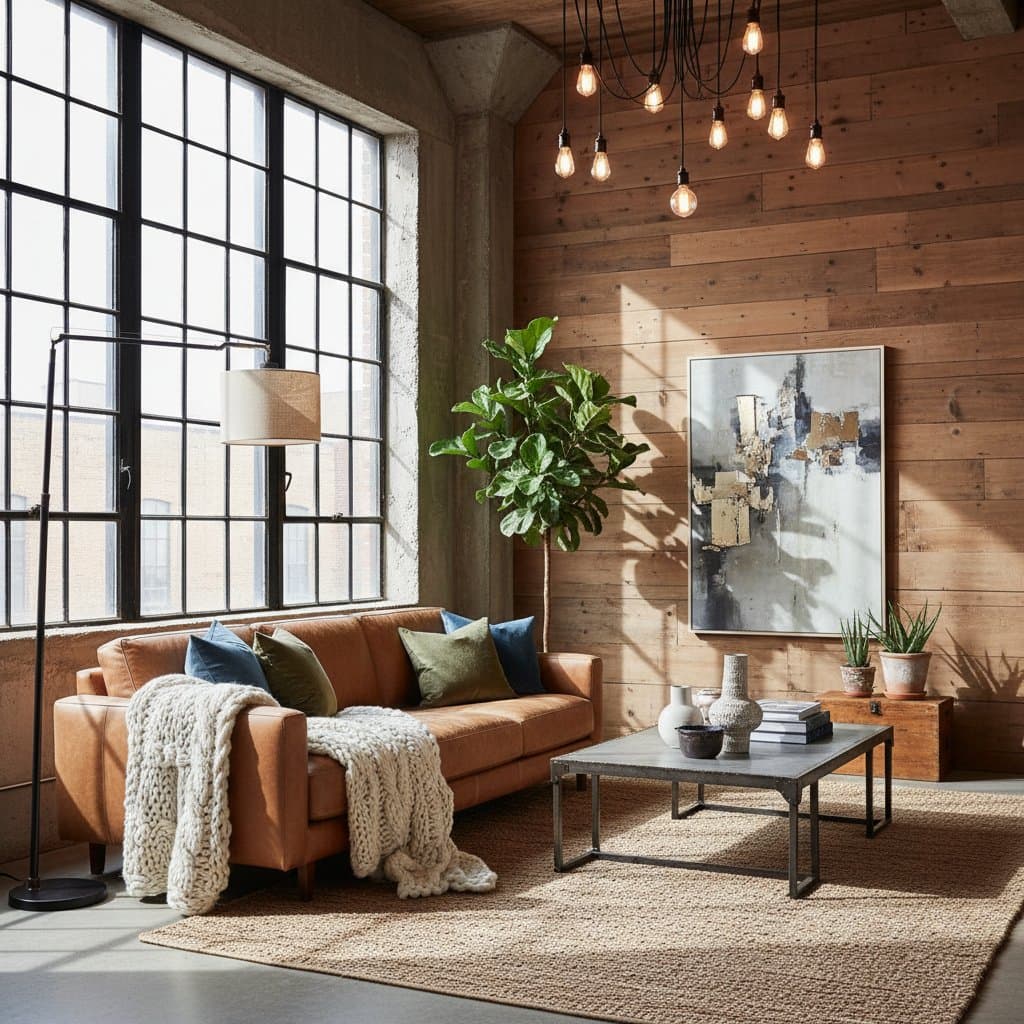Softening Industrial Style with Raw Materials
Industrial design captivates with its honest exposure of structural elements, from weathered brick to sleek metal frameworks. However, these features can sometimes render a space impersonal or chilly. Designers achieve equilibrium by incorporating raw materials that introduce organic warmth, ensuring the aesthetic remains true to its roots while becoming more habitable.
This approach preserves the genre's minimalist appeal. Select materials that complement rather than compete with foundational industrial components. The result is an interior that feels both robust and welcoming, ideal for homes or workspaces seeking character without excess.
Achieving Balance in Industrial Interiors
Core industrial materials such as steel beams, glass partitions, and polished concrete provide a solid foundation. These elements convey durability and openness, yet they often lack tactile comfort. Introduce counterbalancing materials to mitigate this effect, focusing on those that offer natural variations in grain, patina, and pliability.
Wood in its reclaimed form, full-grain leather, and coarsely woven fabrics serve as ideal partners. They add subtle color shifts and sensory depth without overwhelming the palette. Consider the scale of your space; in larger lofts, broader applications like wooden accent walls enhance coziness, while smaller rooms benefit from targeted pieces like upholstered seating.
Key Raw Materials for Adding Warmth
Select materials that align with industrial authenticity, prioritizing sustainability and durability. Below, explore options with practical integration tips to elevate your design.
-
Reclaimed Wood
Reclaimed wood brings inherent narrative through its aged surfaces and irregular patterns. Use it for custom shelving units that line exposed brick walls, or craft dining tables that anchor open-plan kitchens. The warm undertones of oak or barn siding contrast effectively with cooler metals, creating visual interest.
Source from local salvage yards to ensure eco-friendliness. Installation requires securing pieces to withstand humidity fluctuations, and a light oil finish preserves the raw appearance while protecting against wear. -
Full-Grain Leather
Leather introduces a luxurious tactility that softens rigid surroundings. Opt for armchairs or ottomans in earthy hues like chestnut or tobacco, positioned near steel-framed windows to draw the eye. This material withstands daily use, developing a richer patina that enhances over years.
Maintenance involves biannual conditioning with natural oils to prevent cracking. Pair leather with neutral cushions for added layering, ensuring the piece integrates seamlessly into the industrial framework. -
Textured Textiles
Fabrics provide immediate auditory and visual softening in echo-prone industrial settings. Layer woolen area rugs over concrete floors to dampen sound and define zones, or hang linen drapes that filter light through large factory-style windows. These elements introduce subtle movement and depth.
Choose undyed or minimally processed options for authenticity. Experiment with combinations, such as a chunky knit throw over a leather bench, to build texture hierarchies that guide the room's flow. -
Treated Concrete
Concrete remains a staple, but refining its finish elevates usability. Apply a honed sealant to floors for a velvety matte surface that reduces slipperiness without gloss. In walls, trowel-applied overlays mimic raw pour effects while allowing embedded heating coils for year-round comfort.
Professional application ensures even coverage. Complement with adjacent warm materials, like wooden baseboards, to frame the concrete and prevent it from dominating the palette. -
Exposed Brick and Natural Stone
Brick walls or stone hearths deliver grounded warmth through their earthy compositions. For non-original structures, install thin brick slips over drywall to replicate aged patina. Stone elements, such as slate ledges, add subtle elevation to entryways.
Seal surfaces with penetrating protectors to minimize maintenance. Balance these rugged features by surrounding them with softer counterparts, like potted greenery on wooden stands, to foster a harmonious blend.
Integrating Materials for Cohesive Design
Successful industrial interiors rely on deliberate juxtaposition. Contrast rough-hewn wood against gleaming fixtures to highlight each material's strengths, or layer matte textiles over reflective surfaces for dynamic play. In a living area, for instance, position a leather sectional against a brick backdrop, topped with woven pillows for tactile variety.
Lighting amplifies these interactions. Install adjustable track lights with warm LED bulbs (around 2700K) to accentuate wood grains and fabric weaves. In vaulted spaces, pendant fixtures with perforated metal shades cast patterned shadows, drawing attention to textured floors below.
Test combinations through mood boards or sample placements. This method reveals how materials interact under varying light conditions, refining the overall composition before commitment.
Practical Steps to Implement Changes
Begin with assessment: Survey your space to identify cold zones, such as bare concrete expanses or unadorned metal shelves. Prioritize one area, like a seating nook, for initial material introduction.
Procure samples to evaluate in situ. For a starter project, incorporate a reclaimed wood side table paired with a textured runner rug; observe how these shift the room's energy over a week.
Scale up thoughtfully during renovations. Consult fabric swatches against existing fixtures to maintain color cohesion, and budget for professional sealing on concrete or brick to ensure longevity.
Realizing Warmth in Everyday Spaces
Raw materials transform industrial design from austere to approachable, fostering environments where functionality meets serenity. This evolution not only enhances aesthetic appeal but also promotes well-being through comforting surroundings. Embrace these elements to craft a personal sanctuary that endures, blending raw honesty with inviting nuance.
